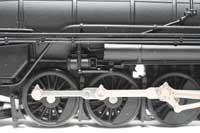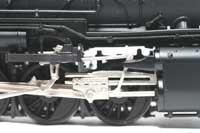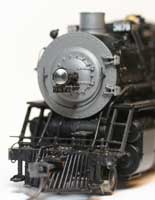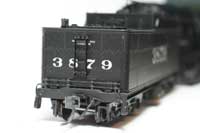| 

click
the above for enlargements Background The
saga of the Broadway Limited ATSF 3800 2-10-2 goes back several years and has
developed simultaneously with Broadway's development as a company.
Broadway
Limited has raised the stakes for prototype model railroading. They were new kids
on the block and have come on the scene in a major way. Most of their products
appeared with little forewarning and are very railroad specific. They have also
been pioneers in sound locomotives. All of this together has encouraged other
manufacturers to do more rapid prototyping and raise sound to a higher level.
However, the 2-10-2
production was not rapid. Broadway moved their offices, changed staff and changed
manufacturers in China during this time. Hopefully some of the adolescent mistakes
will mean a more mature production in the future. John
Moore was involved in early critiques of the locomotive but seems to have been
lost in the changes at BLI. When they saw critiques of the pre-production locomotive
on the society website, they contacted me to tweak the model. To their credit,
several changes were made to improve its performance and appearance. Credit should
be given to John Moore, Don Borden, Paul Brown and Andy Sperandeo for their assistance
in the whole process. They have been the brains behind this compilation.
Prototype The
3800 was announced showing photos of the modernized loco. However, when the photos
of the pre-production engine hit the website, the criticism began to flow. It
was an as-built oil burner. The plans appear to be from Plans for Model Railroaders,
1948 edition and 1953 edition, published by the Santa Fe. The
3800 class included locos 3800 - 3940, minus 3829 mentioned below. But not all
were the same, and modifications through their lives made each one unique. They
were produced 1919-1927 and lasted as late as 1955. The
units produced by BLI will accurately represent 3876-3882 during their early life.
The
2-10-4 will is 3829, Santa Fe's first 2-10-4 and an experimental and developmental
engine toward the later 2-10-4 engines. It was born with a 4 wheel trailing truck
and a 15K coal tender. Other than the trailing truck it was a standard 3800. It
received a 20K long coal tender in 1930 which was converted to oil in the late
thirties. The 15K tender with the model is not correct for any of its configurations.
Below is a list of published
photos of the specific engine numbers that Broadway Limited has chosen. I would
invite others to submit additional listings and notes.
#3876
-
Jeff Ainsworth Santa Fe Steam Series Volume 11, p. 47, 48, and 49 has photos of original and modernized versions.
#3877,
I have not seen one in print.
#3878
- Jeff Ainsworth Santa Fe Steam Series Volume 11, p. 50 -52 has photos of original version both engineer and fireman side and a modernized photo.
#3879
- Santa
Fe in the Mountains, p. 69, has 3879 leading a freight down Cajon Pass near
Sullivan's Curve. It is the modernized version. Most of the consist is visible.
- Cajon: Rail Passage to the Pacific,
p. 181, has a color photo of 3879 pulling into Summit, CA, as front helper on
a 1948 train. Again it is the modernized version.
- Cajon:
A Pictorial Album, p. 117, has a color photo of 3879 on the point of a train
at Summit, 5/29/50, as modernized.
- The
Warbonnet, 4Q 2003, p. 22 contains the same color photo seen in Cajon: Rail
Passage above.
- Jeff Ainsworth Santa Fe Steam Series Volume 11, p. 53-54 has photos of original and modernized version both fireman side.
- http://photoswest.org/cgi-bin/imager?00002035+OP-2035
as the model
- http://photoswest.org/cgi-bin/imager?00001022+OP-1022
as the model
#3881
- Santa
Fe: Steel Rails Through California shows 3881 at Victorville in 1947. It does
not have drifting valves, but does have extended cab, flip smote deflector, and
disk main driver.
- Jeff Ainsworth Santa Fe Steam Series Volume 11, p. 55 has photos of modernized version engineer side without drifting valves. 1947 in Los Angeles.
#3882
- Jeff Ainsworth Santa Fe Steam Series Volume 11, p. 56 -57 has photos of original and modernized version both engineer and fireman side.
#3829
- Santa
Fe's Big 3, p. 19, builder photo with coal tender.
- Steam
Locomotives of the Santa Fe, p. 105: - Santa Fe photo, squarely on the fireman
side, coal tender, as delivered with 1 sand dome.
- 3/4 shot, engineer's side,
1954, San Bernardino, 20K oil tender with SANTA FE on it, drifting valve clearly
shown (Ellington calls "valve by-pass).
- 3/4 shot, fireman's side, 20K
oil tender with number only on it, no drifting valve, no other data.
- Model
Railroader Cyclopedia Vol. 1 Steam Locomotives, p. 84, two shots, both of
the fireman's side, one early with coal tender and one with later trailing truck
(changed 1925) , Elesco heater pump and drifting valve, SANTA FE on tender.
- Iron
Horses of Santa Fe Trail, p. 336, 3/4 shot of engineer's and one of fireman's
side, Raton, 1950, drifting valve, Raised roof on cab, SANTA FE on tender
- Santa
Fe Texas Type 2-10-4 (Ainsworth), p. 7, 3/4 shot engineer's side, Raton, 1949,
drifting valve, SANTA FE on tender
- Santa
Fe's Raton Pass:
- p. 127, front of boiler only, engineer's side, drifting
valve
- p. 134, fireman's side, as built, coal burner, one sand dome.
- Santa
Fe Steam, the Last Decade, p. 67 3/4 shot, fireman's side, oil, no drifting
valve, no SANTA FE on tender. Text: "worked until 8-29-53 with its last years
devoted to freight and helper service on the NM Division."
- Iron
Horses of Santa Fe Trail, p. 340, (no photo) sold for scrap 8-9-55
- Locomotive
Quarterly 26:4, p. 32, good side shot, engineer's side, oil tender, 9-3-48,
drifting valve, two sand domes, Albuquerque.
Tender:
- Steam
Locomotives of the Santa Fe:
- p. 236, drawing from Santa Fe's Car and
Locomotive Plans for Model Railroaders. 15K oil tender.
- p. 238, 20 K
tender, oil and coal.
Therefore,
for the prototype modeler, the 2-10-2s are accurate only for the 1920s-30s and
only for locomotives 3876 - 3882. The 3829 is not accurate for any time period.
The undecorated version can be adapted for 3800-3890 with many exceptions.
Review
of the Model Tender:
- Very
nice looking tender! It follows Ellington's plans for the 15K oil tender nicely.
- The
step that goes from the lower level of the tender to the top of the oil bunker
should be slightly to the fireman's side, and there should be a hand hold to assist
in climbing to the top of the tank. The strap which secures the oil bunker to
the tender is shorter under that step.
- Overall,
excellent job. I hope they make the tender available separately.
- The
QSI sound system and decoder are located in the tender. The tender hatches open
to reveal a rheostat to control sound volume.
- Santa
Fe was omitted from the tender since the loco generally represents a pre-1940
configuration.
Locomotive
- The
cab looks good except:
- No cab sunshade,
or the shade is rolled up. This can be added using the 3751 model as an example.
-
The hatch on the roof is a vent that raised for ventilation. BLI's version is
non-descript.
- The windows are
thick and not very appealing.
- The
loco is too long
- Wheelbase is 1'
too long.
- Driver wheelbase is 9"
too long
- Drivers are 3" too
small (to be expected to allow for flanges.
- From the rear of cab to pony truck axle is 2'7" too long (3/8")
- There
is a line that runs much of the distance of both sides of the boiler. It represented
a seam in the boiler jacket, but it is very thick.
- The
whistle and pop valves are brass. However, in real life they would have been blackened
by use. Only the bell would have been polished.
- The
builder plate is blank. It would be nice to have data in that spot.
- The
stack is too tall per Ellington's drawing. Many modelers would like a selection
of stacks like were on the 3751, as later versions did have a variety of stacks.
The stack is a separate molding and is press fitted so that a modeler can make
his own if he desires.
- There were
3-rung ladders on each side hanging over the valve gear. This has been added by
BLI after initial reviews but without instructions for attaching them. Photos
in Ainsworth's 3800 class book demonstrate that these ladders were not consistently
attached to all 3800 locomotives. One needs to use photos to be sure of his prototype.
(A good example is 3824 in 1930-31 with ladder, in 1937 and 1946 without, and
in 1950-52 with.)
- The loco comes
with a rubber tired driver either installed or separate depending on who packed
it. Some folks like traction wheels, others hate them, but the extra driver is
included so that the modeler can use whichever he wishes.
QSI
Sound
The
sound system has been excellent on my engine. I especially like the whirl of the
steam generator as the headlight slowly brightens. The mechanical adjustment of
the sound volume goes from off to loud to louder. When I get around to programming
the locomotive, there may be more sedate sound levels available. Unfortunately,
QSI decoders have their own programming instructions that differ from other manufactures
so buyers should follow the included instructions with care. I have reset BLI
locos to factory settings more than once to correct my errors.
Unpacking
the model
- When
my loco was received, it would not do anything. I removed the tender and reset
the decoder; that solved the electrical problem.
- Then
the tender would not stay on the track. I noted one of the tender axles had shifted.
I removed the truck, moved the metal electrical pickup piece back into its proper
place, and replaced the truck.
- The
headlight was very crooked and did not light well. I wiggled it until it came
loose and noticed that the brass mounting pin was bent. Using needle nose pliers
I straightened the pin and reattached it.
- Most
modelers are "modelers," so these issues should be easy for them to
correct. A heavy model packed in foam traveling half way around the world, including
part of that in the US Postal Service gets some difficult treatment.
Steve Sandifer Photos:
click for enlargements. (Excuse the dust, I've been working on the railroad.) 


 

Corrections
and input to Steve Sandifer.
|














